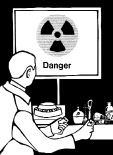IT’S STARTING to look like the U.S. Department of Energy’s ultimate solution for nuclear waste, Yucca Mountain in Nevada, isn’t going to happen: certainly not by 2010, as currently planned; maybe never. And if Yucca Mountain turns out to be a wash, guess what 600-square-mile stretch of sagebrush and already radioactive dirt and groundwater is going to end up with the goodies?
As the Post-Intelligencer‘s Lisa Stiffler reported April 18, the U.S. Department of Energy (DoE) continues to welcome about 100,000 cubic feet a year of miscellaneous radioactive and/or otherwise poisonous material to its Hanford Reservation in Eastern Washington, where it ends up buried in shallow pits that wouldn’t meet the safety standards of a suburban garbage landfill.
Citizens of Washington state had better hope that Gov. Gary Locke wakes up to hear the Geiger counter soon. Spent nuclear fuel continues to accumulate at reactors all across the country, raw material for the first suicidal terrorist band inclined to put it to use. When the U.S.’s pro-nuke Secretary of Energy Spencer Abraham signed off on the Yucca Mountain repository plan in mid-February, he declared that “sound science” supported the safety and security of the site. He appears to be the only person to think so; certainly no scientist willing to be named has taken that position. The government’s own analysts certainly don’t: Advisors to the Nuclear Regulatory Commission reported last September that the DoE’s optimistic rating of the Yucca Mountain site was based on models “that mask a realistic assessment of risk” and on “computations and analyses [that] are assumption-based, not evidence supported.” (Translation: The numbers are invented, and the models are rigged.)
In December, the General Accounting Office said that the DoE wouldn’t even be able to get its data together in one place on schedule, let alone massage it into acceptable shape. And in January, another pesky advisory bunch called the Nuclear Waste Technical Review Board said it had “limited confidence in current performance assessments” for the proposed nuclear-waste sanctuary under Yucca Mountain and that the reliability of predictions on how well it would perform was “weak to moderate.”
If any more nails were needed to secure the coffin lid on Yucca Mountain as a solution to the nation’s nuclear-waste dilemma, they are provided by the bagful in an article in last Friday’s issue of Science, the weekly voice of the American Association for the Advancement of Science. In a “policy forum” surveying the thousands of pages the DoE has published in support of its Yucca Mountain repository plan, nuclear engineer Rodney Ewing of the University of Michigan and MIT security analyst Allison Macfarlane poke through and find almost nothing to commend.
Here’s the biggie: A good 95 percent of the total waste that the DoE wants to store is uranium oxide, which heats up and even burns in the presence of water. The whole point of burying waste at Yucca Mountain is that so little rain falls there and the rock is so impermeable that water from the surface could never reach the tunnels 1,000 feet below, where the sealed wastes are to be stored.
Well, back in 1996, somebody noticed traces of radioactive chlorine in the rock walls of a test tunnel: a form of radioactive chlorine produced only in open-air nuclear weapons tests that then bonds with water. Since the last nuclear weapons test (that we know of) took place in 1963, and since that’s less than 40 years ago, it looks like the DoE’s estimates that surface water couldn’t penetrate 1,000 feet of Yucca Mountain rock in a million years are a little off. The DoE’s solution? Would you believe building a little tin roof over each canister of waste so that if water did by any chance get in, it would, you know, just drip off harmlessly?
Read as a whole, Ewing and Macfarlane’s dry description of the ways the DoE engineers have tried to save their project’s bacon seems like a scenario for Dr. Strangelove II. It would be hilarious but for two things: There’s not the slightest evidence so far that Yucca Mountain will ever be a suitable place to store radioactive waste, and there’s enormous and growing pressure on the government to find someplace to store it.
One reason cleaning up Hanford hasn’t been pressed more urgently is that most of the people in the neighborhood make a living one way or another from the place. The Tri-Cities would be an economic disaster area like Yakima if it weren’t for the billion dollars or so a year the DoE pumps into the economy. Locals are already licking their lips over the prospect of additional billions for a new project designed to “vitrify” Hanford’s own lethal liquid waste.
Which, once vitrified, is supposed to go to Yucca Mountain. Where it looks more and more like it’s never going to go. Do you see a pattern beginning to emerge? If Nevada continues to be a bad sport, what better fallback location than the one that’s already soaked up 140,000,000 curies of radioactivity? (Chernobyl released a little over one-third that much.) Especially since nobody in a position to draw lines in the sand or threaten civil disobedience seems to mind that much.
Roger Downey’s science column appears every other week.









